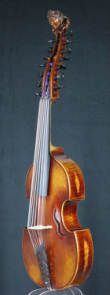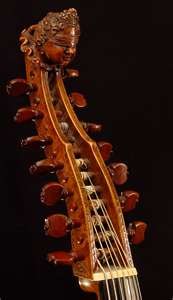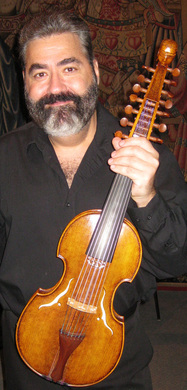Richard Fleischman, viola and viola d'amore
My viola d'amore made by Martin Biller, op 95.
Based on Jean Baptiste Deshayes Salomon 1740

To the left is a photo of my viola d'amore, built by Martin Biller in 2011. The instrument is a copy of the 14-string viola d'amore by jean Baptiste Deshayes Salomon made in 1740.
The viola d'amore shares many features of the viol family. It looks like a thinner treble viol
without frets and sometimes with sympathetic strings added. The 6 string viola
d'amoure and the treble viol also have approximately the same ambitus or range
of playable notes. Like viols, it has a flat back. Intricately carved head at
the top of the peg box are common on both viols and viola d'amoures as well
(although some viols lack them). Unlike viols, the head occurs often with
blindfolded eyes to represent love. Its sound-holes are commonly in the
shape of a flaming sword (suggesting a Middle Eastern influence in its
development). This was one of the three usual sound hole shapes for viols as
well. (The other two being f-holes for viols with "violin shape" and C-holes or
flame holes on the "viol shaped" viols.) It is unfretted, and played much like a
violin, being held horizontally under the chin.

It is about the same size as the modern viola. The viola d'amore usually has six or seven playing strings, which are sounded by drawing a bow across them, just as with a violin. In addition, it has an
equal number of sympathetic strings located below the main strings and the fingerboard which are
not played directly but vibrate in sympathy with the notes played. A common variation is six playing strings, and instruments exist with as many as fourteen sympathetic strings alone. Despite the fact that the sympathetic strings are now thought of as the most characteristic element of the
instrument, early forms of the instrument almost uniformly lacked them. The first unambiguous reference to a viola d'amore without sympathetic strings does not occur until the 1730s. Both the types continued to be built and played through the 18th century. Largely thanks to the sympathetic strings, the viola d'amore has a particularly sweet and warm sound. Leopold Mozart, writing in his Versuch einer gründlichen Violinschule, said that the instrument sounded "especially charming in the stillness of the evening."The first known mention of the name 'viol d'amore' appeared in
John Evelyn's Diary (20 November, 1679): "for its swetenesse & novelty, the Viol d'Amore of 5 wyre-strings, plaid on with a bow, being but an ordinary violin, play'd on Lyra way by a German, than which I never heard a sweeter Instrument or more surprizing..." LISTEN TO THE VIOLA D'AMORE
equal number of sympathetic strings located below the main strings and the fingerboard which are
not played directly but vibrate in sympathy with the notes played. A common variation is six playing strings, and instruments exist with as many as fourteen sympathetic strings alone. Despite the fact that the sympathetic strings are now thought of as the most characteristic element of the
instrument, early forms of the instrument almost uniformly lacked them. The first unambiguous reference to a viola d'amore without sympathetic strings does not occur until the 1730s. Both the types continued to be built and played through the 18th century. Largely thanks to the sympathetic strings, the viola d'amore has a particularly sweet and warm sound. Leopold Mozart, writing in his Versuch einer gründlichen Violinschule, said that the instrument sounded "especially charming in the stillness of the evening."The first known mention of the name 'viol d'amore' appeared in
John Evelyn's Diary (20 November, 1679): "for its swetenesse & novelty, the Viol d'Amore of 5 wyre-strings, plaid on with a bow, being but an ordinary violin, play'd on Lyra way by a German, than which I never heard a sweeter Instrument or more surprizing..." LISTEN TO THE VIOLA D'AMORE
